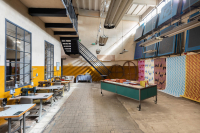The Department of Colour and Light
Muzeum Lniarstwa im. Filipa de Girarda w Żyrardowie
September 17-25, 2022
Karola Dittricha 18, 96-300 Żyrardów
In The Department of Colour and Light, Włostowska thoughtfully revisits the now-neglected topic of “The artist within the industry”, whose source lies in the interwar period and the constructivist movements of Soviet Russia and the Bauhaus and which was advertised heavily in the two decades after WW2 by newly established institutions such as the Warsaw-based Institute of Industrial Design – the vanguard research and development unit for industrial design, initially dubbed “Office for the Supervision of Production Aesthetics”. It was there that the original Department of Colour and Light, from which the exhibition takes its name, was established – offering research-driven solutions both for the industry and the domestic environments.
Włostowska eagerly revisits this euphoric, enthusiastic atmosphere and the pioneering spirit that accompanied the postwar reconstruction and institutionalisation of the so-called “Polish School of Textiles” of the mid-1940s to 1960s, not only studying the works, but also the writings of such authors (artists, designers and often professors or facilitators) as Wanda Cios-Nowakowska, Anna Fiszer, Ada Kierzkowska, Aleksandra Michalak-Lewińska, Hanna Milewska, Krystyna Policzkowska-Gałecka, Adela Szwaja, and Józefa Wnukowa, who were all engaged in various artistic media including both “industrial” textile techniques (screenprint, monotype, jacquard, etc.) as well as more artistic, “freestyle” expressions (gobelin, hand-painted silks etc.), and collaborated with such notable institutions as the Institute of Industrial Design, the legendary “Sopot School” (established by Wnukowa) and the “Ład” Cooperative, the Silk Factory in Milanówek, the Linen Factory in Żyrardów, and many others.
Apart from paying tribute to her predecessors, Włostowska’s own, boldly coloured textiles featuring graphic, abstract geometrical patterns are also reminiscent of pieces by the so-called Op-Art movement: a movement that, similarly to Neo-Impressionism, was based on scientific premises analysing the mechanics and quirks of our optical perception, offering vibrant, contrasting colour compositions that introduced the notion of movement not only within the work itself, but also through analysing the interaction between the work and the space around it.
Klara Czerniewska-Andryszczyk
Exhibition and mural were realised within the frame of a grant by the Polish Ministry of Culture for the year 2022 and in co-operation of Linen Museum in Żyrardów.
Photography: Anna Zagrodzka
















.jpg)











